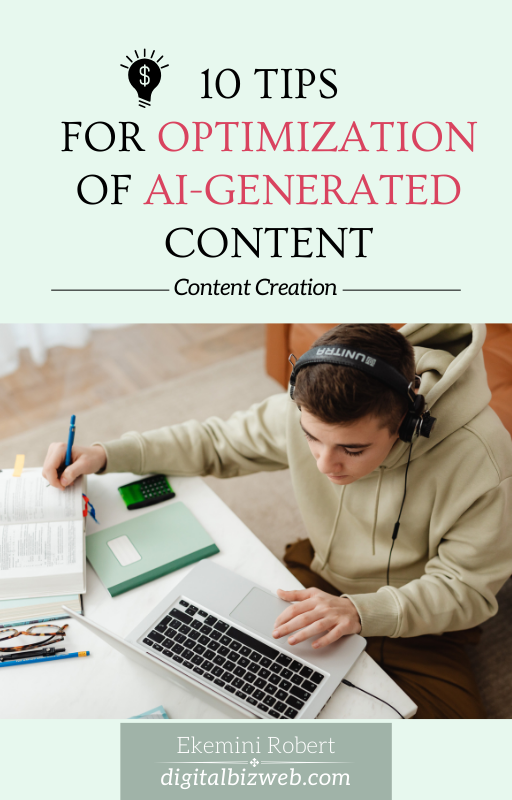Yep, you’ve fallen into the trap of relying too much on autogenerated content. Sure, it’s convenient – saves you time and all of that – but now you’re wondering if it’s doing more harm than good.
Maybe not. You just purchased a new website you may or may not have known it’s filled with AI content. Now you know so what do you?
Or maybe you have just a few posts generated with the help of AI and Google is all over you with their recent spam and “helpful” content update.
You know you need to mix things up, inject some freshness into your content. But where do you even begin?
Your blog may be overflowing with autogenerated articles, and the thought of overhauling everything feels overwhelming.
Don’t stress out just yet. In this blog post, we’ll explore why too much autogenerated content isn’t ideal and more importantly, we’ll dish out some practical tips to help you turn things around.
If you want to know how to create and optimize content using AI, saving time, reducing cost, and generating even more revenue producing content at scale, get my book where I show you exactly how you can do it.
Table of Contents:
What is AI Content?
First, you need to know what constitutes AI content and when it’s just too much for your website.

Autogenerated content is basically like content on autopilot. It’s created by computer programs, using algorithms to pull together information from different sources and mash it up into new articles. Sounds pretty fancy, right?
Sure, it’s quick and easy – just set the program to churn out articles and watch the magic happen. But you can never generate original and helpful content putting together what has already been.
This kind of content often lacks that personal touch that comes with content written by a human.
It’s like serving up a frozen TV dinner instead of a homemade meal. Sure, it might fill you up, but it’s missing that special something that makes it truly satisfying.
Now, let’s compare that to the normal content creation process.
When you’re creating content the old-fashioned way, it’s all about you putting in the time and effort to research, write, and edit your posts.
You’re the brains behind the operation, crafting each word and sentence with care to make sure it’s just right.
It’s a “labor of love”, but it’s worth it when you see your readers enjoying what you’ve created.
Truth is, your readers can tell when something’s off, and if they’re constantly seeing the same generic articles churned out by a computer, they’ll start tuning out.
And that’s where things can start to go downhill. When your blog is flooded with autogenerated content, it starts to feel… well, robotic.
They might have all the right words, but it just feels off.
So, when is autogenerated content just too much? The way I see it, AI content is too much when it comes straight out of the AI without being proofread and edited by a human being.
So it’s less about how much of it was written by an AI and more about how much value you are adding to your readers.
Your readers come to your blog for your unique perspective, your insights, your personality.
If all they’re getting is a bunch of soulless articles generated by a computer, they’ll start looking elsewhere for their fix.
So take a step back, evaluate what’s working and what’s not, and get ready to breathe some new life into your content. Your readers will thank you for it.
Recommended Read: Will AI Replace Content Writers?
What to do if you have too much AI Content
Now that we know what the problem is, it’s time to fix it. It’s not all doom and gloom.
However, depending on the value of the AI content or keywords, and the amount of work needed to optimize the autogenerated content, you’ll need to decide the ones to keep and the ones to trash.
To fix your website, start by finding out how much AI content you have.
Find out the amount of AI content on your Website
It’s like going on a treasure hunt, but instead of gold doubloons, you’re hunting down autogenerated articles.
Here’s how to go about it:
1. Check Analytics: Whether you’re checking for AI content or not, the performance of each article on your website will let you know the ones that are useful or and the ones that are not.
So one good way to gauge the amount of AI content on your website is by taking a peek at your analytics and search engine data.
Look for patterns in your articles – are they mostly autogenerated? Are there articles hit by the most recent core update from Google?
You may not like Google, but sometimes they can lead you to content that isn’t as good as you thought it was.
Collect those articles in one folder or spreadsheet so you can take a closer look at them.
Depending on the relevance and usefulness of the content at the time, you should be able to know which to get rid of, or the ones you need to keep, repurpose or rewrite.
If you have thousands of articles, then you may have to hire writers to help you work things out.
2. Use Tools: Spending hours scouring through your website manually is ust not possible if you have hundreds or thousands of posts to look at.
Fear not – there are tools out there that can do the heavy lifting for you.
There are plenty of AI content detection tools and plugins available that can analyze your website and flag any autogenerated content they come across.
An example is the content at scale AI detection tool and originality.ai. And with Originality.ai, you can simply check content by entering a URL.
So pick your articles and drop them there. The tool will analyze those articles and let you know if they were generated by a robot.
As earlier mentioned, unless you have a way to automate the process, you may need a small team if you have thousands of web pages to analyze.
3. Manual Check: This only makes sense if you have like 10 to 20 articles to check. But don’t get lazy now.
Start by pulling up your website and scrolling through your articles one by one.
Keep an eye out for any telltale signs of autogenerated content – you know, stuff like wonky grammar, weird formatting, or topics that seem a little too random.
Make a note of each article that fits the bill, and before you know it, you’ll have a pretty good idea of just how much AI content you had lurking in the shadows.
4. Ask for Feedback: Last but not least, don’t underestimate the power of good old-fashioned feedback.
Reach out to your readers and ask them what they think of your content.
Do they enjoy what they’re getting? If you have a comments session, the feedback there can tell you all you need without having to pose a direct question to your readers.
This information will be very helpful in helping you gauge whether you’re on the right track or if it’s time to switch things up.
In the end, it’s not really about Google or AI detection tools – it’s about how much value you’re giving out to your readers.
Sometimes, simply removing a single letter from your content can change your originality score by as much as 20%. Yes, you heard me right – one single letter!
Even when content is written by an AI writing tool, one misspelled word can strongly affect the AI checkers.
So think more about value and less about AI tools.
Sort out the articles based on needs
If you haven’t already, sort out the articles based on needs.
- Which one needs to be trashed?
- Which needs to be rewritten?
- Which titles and keywords are worth keeping?
- Which needs updating and which one needs repurposing?
You can sort your articles by appending comments or color-coding them in a spreadsheet.
Once you’re done sorting your articles, it’s time to get started optimizing those AI-generated content.
How to Optimize AI-generated Content
Even when you generate content using AI, you need to optimize and humanize the content.
AI saves so much time and helps reduce content creation costs. This is why many go for it.
But if you’re not good at optimizing that content, you’ll be shooting yourself in the foot because wherever that content piece shows up, all the AI detection alarms are going to go all red and noisy.

I’m going to share how to optimize AI content here. If you want even more, get my 10 AI Content Optimization Tips Ebook. It’s free by the way.
Edit the Introduction (if Necessary)
Pay close attention to the introduction as it plays a significant role in engaging the reader. By optimizing the introduction, you can ensure a higher level of engagement.
Sometimes the AI just won’t get it right. So be ready to start your blog post with the energy that reflects your passion and personality and sets the reader up for what you have for them.
Break Lengthy Paragraphs
When it comes to content, the easier it is to digest, the more likely your readers will stay hooked.
Some AI content will have sentences and paragraphs that are just too long. Break them up and simplify complex sentences.
Look for natural breaks, such as a change in topic or a transition in your argument, to split it into manageable chunks.
This allows your readers to easily follow your argument without feeling overwhelmed by large blocks of text.
In addition, include lists and bullet points where appropriate.
For example, if your AI-generated content contains a paragraph listing several key points or tips, consider turning that paragraph into a bulleted list:
- Point 1
- Point 2
- Point 3
Using tables can also be helpful for presenting complex data or comparisons in a user-friendly manner. If your content covers numerical or statistical information, consider organizing it into a table format to simplify it for your readers:
| Data A | Data B | |
| Metric 1 | 50 | 55 |
| Metric 2 | 80 | 72 |
You can simply copy a block of textual information, drop it in your writing tool’s chat feature and ask it to create a table for you.
I once had the AI compare and contrast three ideas. When it was done, I had like 15 bullet points.
So I asked it to create a table for me from that information. A few seconds later it was done. I copied the table, dropped it in WordPress and was ready to go.
Add Links
One of the things really lacking in AI-generated content out there are links – relevant internal and useful external links.
Including internal links can boost your site’s SEO. It will also help users navigate through your content.
By connecting related articles, pages, or resources within your website, you’re encouraging readers to spend more time exploring your content.
Adding authoritative external links too to your AI-generated content will improve its credibility and quality.
Cite Sources
When working with AI-generated content, it’s crucial to cite your sources to maintain credibility and authority.
This portrays you as a helpful source of information both to readers and search engines.
This also means that readers can fact-check the information you present to them.
Use data
One of the things I notice when asking questions that involve facts, is that Google tends to come up with results that include data to back up the facts.
If you want to rank, suffice to say, you need to include researched data in your article.
Strategically positioned data to back up your answer to a question or stand on an issue will send all kinds of good signals to Google.
Some AI writing tools do this, but they may not be as effective as data you’ve picked on your own to include in the article.
So make a Google search that will get you research data to back your content. Put it in the article, and increase your chances of sending your AI-generated article to page 1.
Remove Unnecessary Repetitions
Something you’ll find in most AI content are unnecessary repetitions.
AI writing tools just know how to repeat ideas in individual sections. Look out for these repetitions and replace, rephrase, or rewrite them.
These tools will get better over time. For now, you have to look out for these things.
Recently, an AI company released a tool that helps users remove repetitions from AI-generated content.
If your AI writer does not have this feature, you’ll need to do it manually or prompt your tool to do it for you automatically.
This is why we talked about picking a tool that’s flexible and open to innovative ideas.
Add Visuals
Incorporating visuals such as photos, videos, infographics, and charts into your AI-generated content will increase engagement and enhance the user experience.
According to an article on SproutWorth, “65% of people are visual learners, making visual content an essential part of any marketing strategy.”
This is just one out of a ton of stats that prove visuals should be an essential part of content.
Add a Personal Story
Personal stories help you achieve the following:
Makes Your Article Unique
Incorporating a personal story in your AI-generated content can give it a unique touch. By sharing your own experiences or anecdotes, you create original content that separates your writing from others.
For example:
When I first started using AI-generated content, my articles lacked a human touch. But after adding personal stories, I noticed a significant improvement in reader engagement.
Builds Expertise and Authority
Adding a personal story not only makes your content unique but also helps establish your expertise and authority in the subject matter.
As a content creator, you’re demonstrating your knowledge and experiences in a relatable manner. This fosters credibility and positions you as a trusted source to your readers.
We all want to learn from someone who has tried things out and has gathered experience before coming to teach us.
Enhances Trustworthiness
Sharing your own experiences and challenges adds a level of authenticity to your AI-generated content. It shows readers that you’re not just providing information but have personally encountered the topic at hand. This creates a stronger connection with your audience, ultimately enhancing your content’s trustworthiness.
Some tips for increasing trustworthiness:
- Be honest and transparent.
- Share both successes and failures.
- Provide actionable advice based on your story.
Use Personal/Original Images and Videos
In addition to personal stories, integrating original images or videos can elevate your content’s relatability.
Fact-check
When optimizing AI-generated content, an important aspect is ensuring the accuracy of the information presented.
Don’t ever lift content straight from AI to publish it on your website or newsletter. Take some time to check and correct the facts.
Fact-checking helps make certain that the details used in your content are credible and up-to-date.
This is essential for maintaining a positive reputation and providing useful information to your audience.
- If a country swears in a new president, a woman gets married and changes her name, or a new league champion is crowned, an AI may not be up-to-date with these details.
- Sometimes the name of a package, item, tool, or company may change. The AI may still be using the old names in your article.
Look out for these when optimizing AI content.
Take steps to keep out unhelpful Autogenerated Content
Life itself has taught us that it’s better to be safe than sorry.
Taking steps to keep out unhelpful content from your website is better than having to try to deal with excess unhelpful content.
Here are a few things you can do to keep your site clean and fresh, free of spammy content.
Set Up Content Guidelines
Create clear and concise content guidelines for your website that outline what types of content are acceptable and what’s off-limits.
These guidelines are very important especially if you accept guest posts on your site. These days it’s easy for someone to offer AI content as a guest post.
Be specific about what constitutes autogenerated content and make it crystal clear that it’s a big no!.
Educate Your Team
If you outsource content creation or have a team of writers, make sure everyone on your team knows what quality content is all about.
For me, I’m not against using AI to help with the work. The most important thing is adding value to the reader.
So let your team know what valuable content is all about. Also, be ready to train your writers on how to use AI tools properly.
This way, they can do more work without sacrificing quality.
Regular Content Audits
Keeping up with our content creation schedule is not an easy one. This is why you have to do regular content audit so you can spot unhelpful content that may have slipped through the cracks.
Set aside some time every month or so to comb through your articles and make sure everything checks out.
Monitor Comments and Use Captchas
Consider implementing captchas and verification systems on any forms or submission pages.
These little digital gatekeepers can help weed out bots and ensure that only real, human-generated content makes its way onto your website.
And for new websites, be sure to use a comments check plugin.
But I don’t use a plugin since too much plugins can slow down a website. I just set my comments to wait for moderation.
This way, no comment goes live until I clear it. This ensures everything that shows up on the website is not autogenerated spam.
Best Practices for Creating Quality Content with AI
Using AI writing tools to create quality blog content ‘s like having a trusty sidekick to help you craft killer articles, but like any superhero duo, you need to know how to work together effectively.
Like I always say, while AI will be a gamechanger for most businesses owners, it will also lead to the doom of many.
No,of course, this won’t be you.
Here are some best practices to keep in mind:
Know Your Purpose
First things first, before you start typing away, make sure you’re crystal clear on the purpose of your blog post.
You can be so carried away by the magic of AI that you begin to create content without any clear goals.
Wth AI, some creators are now creating 5 times more content than they did before AI came. This is not a bad thing at all.
But slow down a bit and check to make sure you’re not off track. Be sure you’re not just creating content for fun, but really meeting the needs of your readers.
Provide Clear Instructions
AI writing tools are pretty smart, but they really can’t read your mind. They can’t be you.
This is where careful prompting comes it. Sure AI can produce content in one click but it’s going to be just what every other person is having on their website.
The little effort you put into prompting and finetuning your AI writing tool will make a huge difference.
Be sure to provide clear and specific instructions to your AI tool about what you want your content to be about, the tone you want to convey, and any key points or keywords you want to include.
Although AI is very good at research, there are perspectives it still won’t see because knowledge and experience are two different things.
AI may have the knowledge but will most times lack the experience. No matter how smart you are, there are things you can only learn by experience.
This is why you can’t drive a car by reading a manual. It’s the same reason you can’t become a professional sports player by watching.
Injecting your unique perspective can easily help the AI craft unique and helpful content.
That being said, you need to understand your AI tool. Some tools are better if you don’t tweak them too much. For such tools, you have to type in what you want after it’s done creating the content.
Review and Edit
Once your AI tool has worked its magic, you’ll have to review the content carefully. Don’t get complacent because you have a machine at you beck and call.
This is where many get it wrong with AI.
Take time to check for accuracy, clarity, and coherence.
Edit as needed to ensure that the content flows smoothly and resonates with your audience.
Is Google Against AI Content?

Now to addressing the elephant in the room: Is Google out to get us for using AI writing tools?
Truth be told, after the “unhelpful” content update, this is how many creators feel.
The short answer? Nope, not really. Google isn’t sitting up there in its virtual ivory tower, wagging its finger at every blog post that’s been touched by an AI writing tool.
Do you know that there are AI created blog posts that are even performing better after Google’s update.
Yes, there are people in the Niche Pursuits Facebook group who have posted screenshots of the AI content they have ranking better after the update.
So, let’s break it down: Google’s all about delivering the best possible search results to its users, right.
That means showing them content that’s helpful, relevant, and, well, not garbage. So, when it comes to content generated with AI writing tools, Google’s not against it per se.
What Google’s really after is quality content – stuff that’s actually useful, informative, and original.
Google’s Danny Sulivan made it clear on X (Twitter) what Google things about AI content. Here’s a quote from @dannysullivan on X.
We haven’t said AI content is bad. We’ve said, pretty clearly, content written primarily for search engines rather than humans is the issue.
@dannysullivan on X
But this leads to another question, is Google ranking the best content?
For now the answer is no. The are still struggle with separating the weed from the tares at this moment.
We only have to wait and see where content creation goes from here.
Wrapping Up
If you have excess AI content, don’t just throw in the towel. You can make a lot of good content out of AI content.
However, if you were not part of the content creation process, you may find it harder to optimize such content for quality.
Start by sorting the content which you can keep and the ones you should get rid of.
And lastly, don’t forget. It doesn’t matter how you create content.
What matters is making content that adds value to your readers and the world at large.




